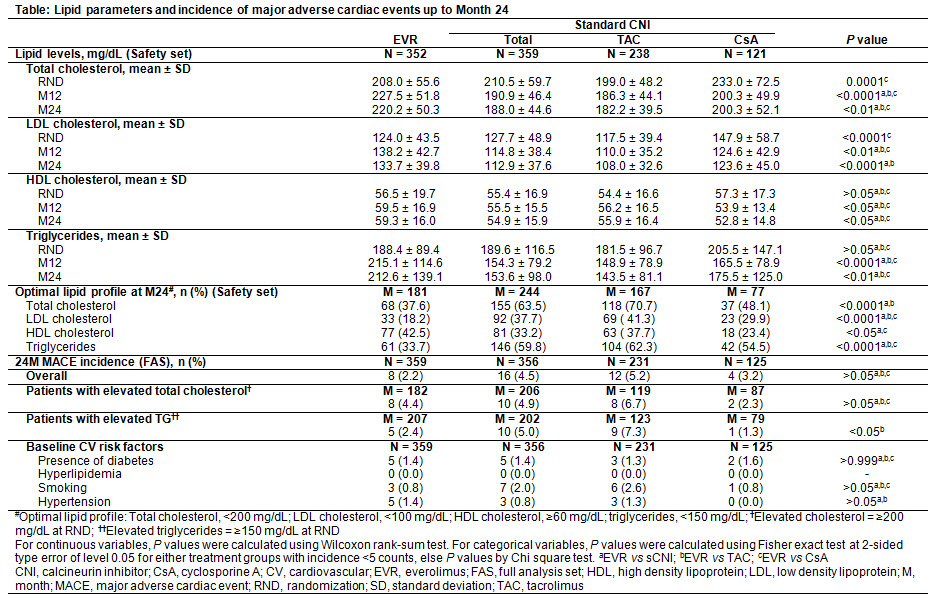Evolution of Lipid Profile and Major Adverse Cardiac Events in Kidney Transplant Recipients Converted from Calcineurin Inhibitor to Everolimus: 24-Month Subanalysis from Elevate Study.
M. van der Giet,1 J. de Fijter,1 F. Oppenheimer,1 G. Russ,1 P. Lopez,2 G. Bader,2 J. Cruzado,1 H. Holdaas.1
1ELEVATE Study Group, Berlin, Germany
2Novartis Pharma AG, Basel, Switzerland
Meeting: 2017 American Transplant Congress
Abstract number: 355
Keywords: Immunosuppression, Kidney transplantation, Lipids, Risk factors
Session Information
Session Name: Concurrent Session: Kidney: Cardiovascular and Metabolic
Session Type: Concurrent Session
Date: Monday, May 1, 2017
Session Time: 4:30pm-6:00pm
 Presentation Time: 5:06pm-5:18pm
Presentation Time: 5:06pm-5:18pm
Location: E451b
PURPOSE: Posttransplant (post-Tx) lipid abnormalities may increase risk of cardiovascular (CV) events in kidney transplant recipients (KTxR). Previous analysis from ELEVATE (NCT01114529) study confirmed that early everolimus (EVR) conversion vs calcineurin inhibitor (CNI) continuation does not increase CV events. Here, we compare 24-month (M) evolution of lipid levels and major adverse cardiac events (MACE) by elevated total cholesterol (TC) and triglyceride (TG) and presence of CV risk factors at randomization (RND) in KTxR on EVR vs standard CNI (sCNI).
oMETHODS: In this 24M, open-label, multicenter study, KTxR were randomized at 10-14 weeks post-Tx to receive EVR (n=360; C0: 6-10 ng/mL) or continue sCNI (n=357; C0: tacrolimus [TAC] 5-10 ng/mL/cyclosporine A [CsA] 100-250 ng/mL) regimen. Evolution of lipid levels and MACE by presence of baseline CV risk factors and elevated TC (≥200 mg/dL) or TG (≥150 mg/dL) levels was compared in EVR vs CNI arms.
RESULTS: At baseline, TC was significantly lower in EVR vs CsA arm (P=0.012). Levels of all lipids progressively increased post-RND such that TC (Table; M12: P<0.0001; M24: P<0.01), HDL-C (M12 and M24: P<0.05), and TG (M12: P<0.0001; M24: P<0.01) were significantly higher in EVR vs sCNI, TAC, and CsA arms up to M24. Significantly lower number of patients in EVR vs sCNI, TAC, and CsA arms had optimal LDL-C and TG levels at M24 (P<0.0001). Concomitantly, significantly higher number of patients in EVR vs sCNI and CsA arms had optimal HDL-C at M24 (P<0.05). In patients with elevated TG, however, MACE incidence was significantly lower in EVR vs TAC arm (P<0.05; Fischer exact test). When MACE occurrence was compared by baseline CV risk factors, overall incidence remained low and nonsignificant between EVR and CNI arms.
CONCLUSION: Elevated lipid levels do not appear to increase MACE in KTxR converted to EVR vs those continued on sCNI up to 24M; however, longer follow-up and risk analysis by treatment arm may be required to further delineate CV benefit with EVR.
CITATION INFORMATION: van der Giet M, de Fijter J, Oppenheimer F, Russ G, Lopez P, Bader G, Cruzado J, Holdaas H. Evolution of Lipid Profile and Major Adverse Cardiac Events in Kidney Transplant Recipients Converted from Calcineurin Inhibitor to Everolimus: 24-Month Subanalysis from Elevate Study. Am J Transplant. 2017;17 (suppl 3).
To cite this abstract in AMA style:
Giet Mvander, Fijter Jde, Oppenheimer F, Russ G, Lopez P, Bader G, Cruzado J, Holdaas H. Evolution of Lipid Profile and Major Adverse Cardiac Events in Kidney Transplant Recipients Converted from Calcineurin Inhibitor to Everolimus: 24-Month Subanalysis from Elevate Study. [abstract]. Am J Transplant. 2017; 17 (suppl 3). https://atcmeetingabstracts.com/abstract/evolution-of-lipid-profile-and-major-adverse-cardiac-events-in-kidney-transplant-recipients-converted-from-calcineurin-inhibitor-to-everolimus-24-month-subanalysis-from-elevate-study/. Accessed January 5, 2026.« Back to 2017 American Transplant Congress
